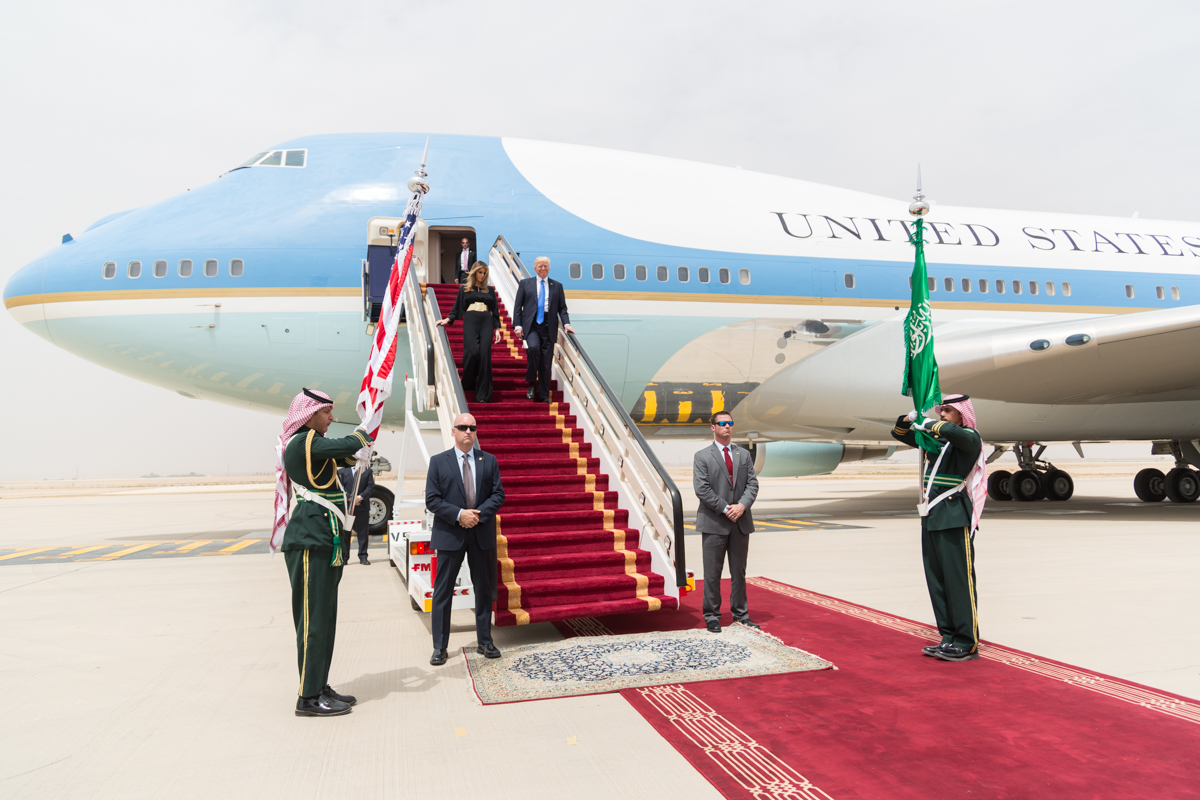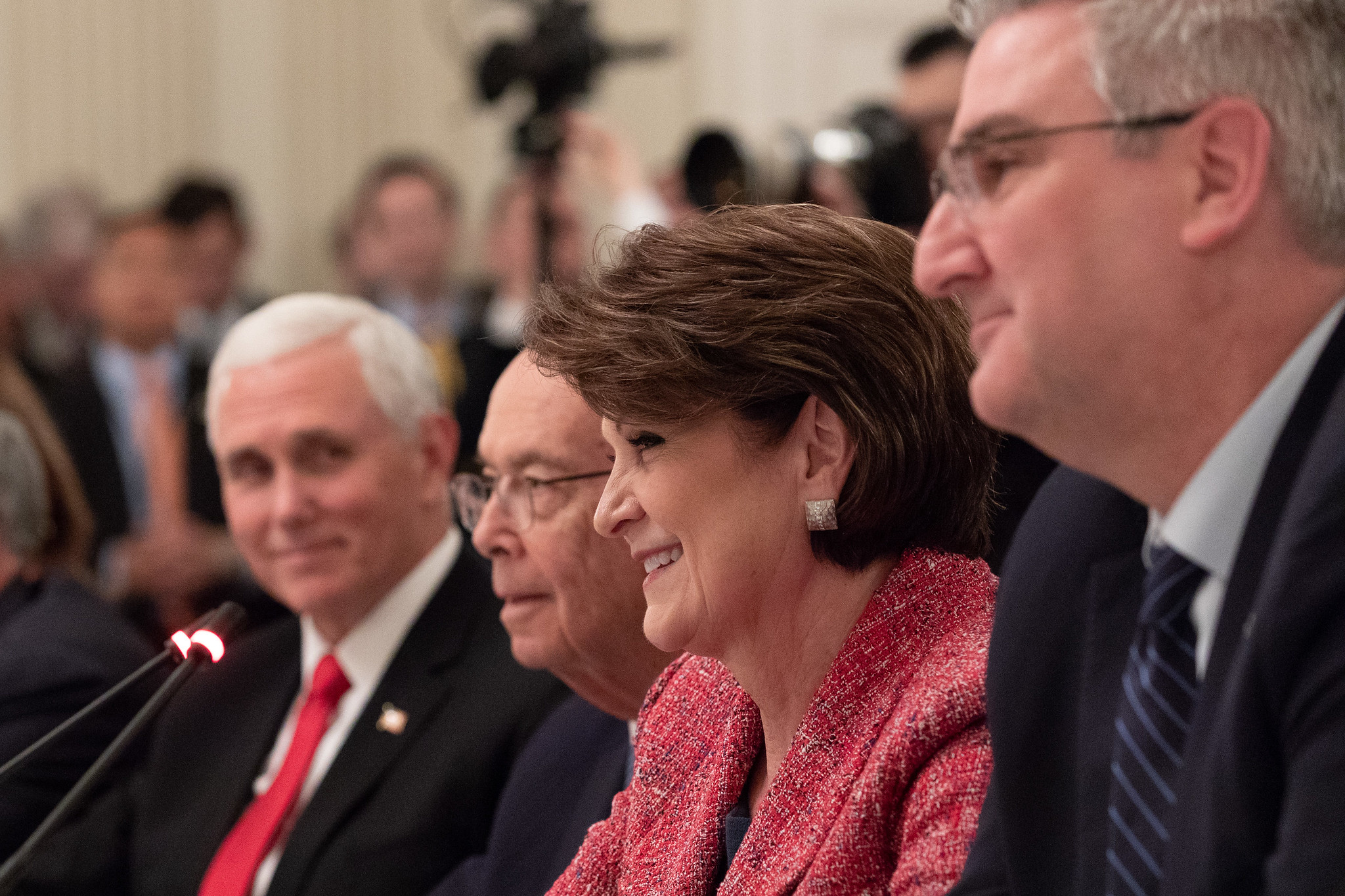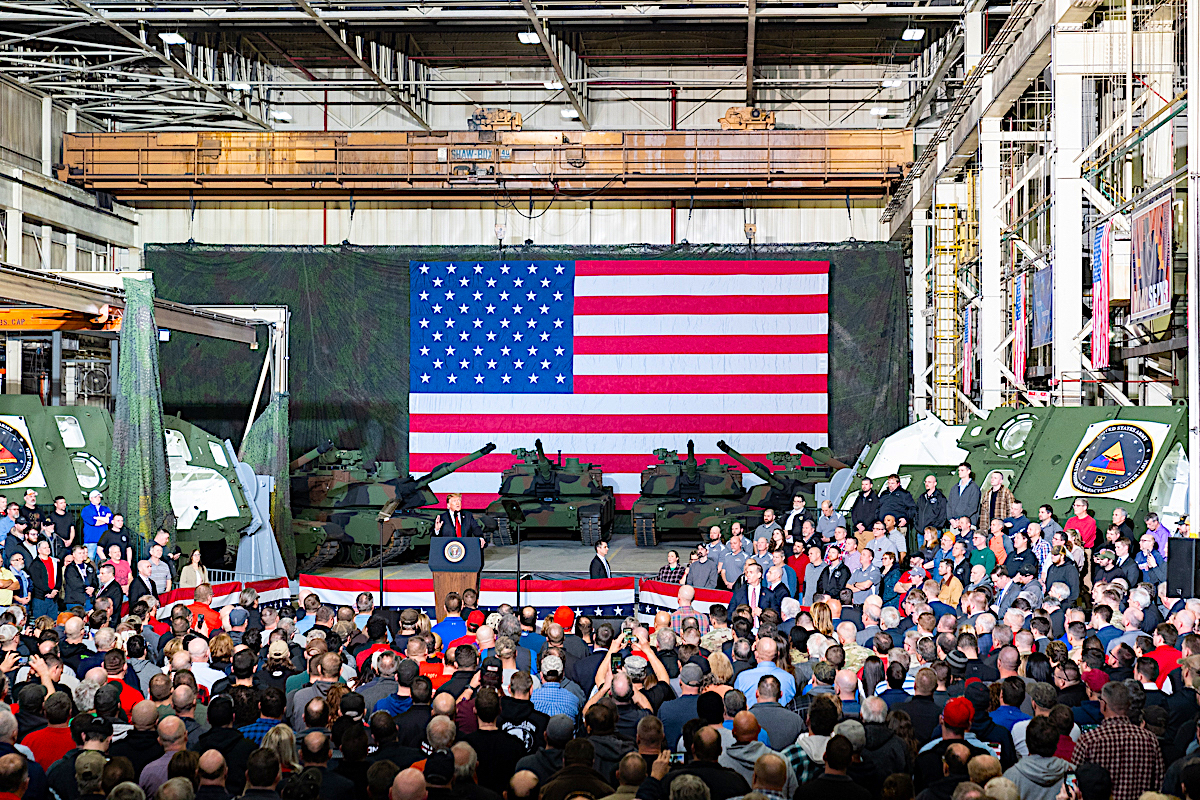The president is making an aggressive effort to parlay Pentagon funding into political support, writes William D. Hartung in this economic analysis of other — and better — job creators.

Donald Trump announced the 2020 re-election campaign in Orlando, Florida, June 18, 2019. (Wikimedia Commons)
By William D. Hartung
TomDispatch.com
 President Donald Trump likes to posture as a tough guy and part of that tough-guy persona involves bragging about how much he’s spent on the U.S. military. This tendency was on full display in a tweet he posted three days after an American drone killed Iranian Major General Qassem Suleimani in Baghdad:
President Donald Trump likes to posture as a tough guy and part of that tough-guy persona involves bragging about how much he’s spent on the U.S. military. This tendency was on full display in a tweet he posted three days after an American drone killed Iranian Major General Qassem Suleimani in Baghdad:
“The United States just spent Two Trillion Dollars on Military Equipment. We are the biggest and by far the BEST in the World! If Iran attacks an American Base, or any American, we will be sending some of that brand new beautiful equipment their way… and without hesitation!”
That tweet was as much a message to the American public as to Iran’s rulers. Its subtext: that Donald J. Trump (and he alone) has restored the U.S. military to greatness after two terms of neglect under the less-than-watchful eye of Barack Obama, that he’s not afraid to use it, and that he deserves credit for everything he’s done, which means, of course, widespread political support. Never mind that Washington has “only” spent about one-third of his claimed $2 trillion on military equipment since he took office and that Pentagon spending reached a post-World War II record high in the Obama years. No surprise there: Trump has never let the facts get in the way of a good story he’s dying to tell.
He has, by the way, made similar claims to his most important audience of all: his donors. At a Jan. 17 get-together with key supporters at Mar-a-Lago, his lavish Florida resort, he bragged that Pentagon spending had increased by $2.5 trillion on his watch. In fact, that figure is closer to total Pentagon spending in the Trump years. For his claim to be accurate, the Pentagon budget would have had to be $0 in January 2017 when he entered the Oval Office. Still, however outlandish what he says about the military may be, the underlying theme remains remarkably consistent: I’m the guy who’s funding our military like never before, so you should keep supporting me big time.
Don’t get me wrong. In collaboration with Congress, Donald Trump has indeed boosted the Pentagon budget to near-record levels. At $738 billion this year alone, it’s already substantially higher than U.S. spending at the peaks of the Korean and Vietnam Wars or during the Reagan military buildup of the 1980s. It’s more than the total amount spent by the next seven nations in the world combined (five of which are U.S. allies). Only Donald Trump could manage to distort, misstate, and exaggerate sums that are already beyond belief in the service of an inflated self-image and ambitious political objectives.
Political Manipulation and “Jobs, Jobs, Jobs”
Trump’s recent antics should come as no surprise. His use of Pentagon spending and military assistance for political gain has been hiding in plain sight since he entered the Oval Office. After all, that’s what the impeachment charges against him were all about. He was manipulating U.S. military aid to Ukraine to strong-arm its government into generating dirt on Joe Biden whom Trump, obsessed by poll numbers, saw at the time as his most threatening rival.
And don’t forget the president’s penchant for dipping into the Pentagon budget to pay for his cherished wall on the U.S.-Mexico border, a vanity project that plays extremely well with his political base. So far, he’s proposed taking $13.3 billion from the Defense Department’s budget to fund that “big, fat, beautiful wall,” $6.1 billion of which has already been granted to him. For good measure, Trump pushed the Pentagon to award a $400 million contract for building part of the wall to Fisher Sand and Gravel, a North Dakota firm owned by one of his donors.
For Trump, the Ukraine scandal and the wall aside, the real politics of Pentagon spending — that is, of translating military dollars into potential votes in 2020 — will come, he hopes, from his relentless touting of the alleged jobs being generated by weapons production. His initial major foray into portraying the buying and selling of arms as a jobs program for the American people occurred during a May 2017 trip to Saudi Arabia, his first foreign visit as president. He promptly announced a $110 billion arms deal with the Saudi regime that would, he swore, mean “jobs, jobs, jobs” in the United States.

President Donald Trump and First Lady Melania Trump arrive in Rihad, Saudi Arabia, 2017 (White House/Shealah Craighead)
In reality, the agreement itself — and the jobs to come from it — were both far less than advertised, but the message was clear enough: this country’s deal-maker extraordinaire was selling weapons over there and bringing jobs back in a major way to the good old U.S. of A. Even though many of the vaunted arms deals he boasted about had been reached during the Obama years, he had, he insisted, gotten the Saudis to pay through the nose for weaponry that would put staggering numbers of Americans to work.
The Saudi gambit was planned well in advance. In the middle of a meeting with a Saudi delegation in a reception room next door to the White House, Trump son-in-law Jared Kushner suddenly called Lockheed Martin CEO Marillyn Hewson. He asked her about a missile-defense system the administration wanted to include in the mega-arms package the president was planning to announce during his upcoming visit to the Kingdom. According to a New York Times account of the meeting, the Saudis’ jaws dropped when Kushner dialed up Hewson in front of them. They were amazed that things actually worked that way in Trump’s America. That call apparently did the trick, as the Lockheed missile-defense system was indeed incorporated into the arms deal to come.

Marillyn Hewson, CEO of Lockheed Martin, at White House meeting March 6, 2019. (White House, Joyce N. Boghosian)
The arms-sales-equals-jobs drumbeat continued when Trump returned home from his foreign travels, most notably in a March 2018 White House meeting with Saudi Crown Prince Mohammed bin Salman. There, in front of TV cameras, the president brandished a map showing where tens of thousands of U.S. jobs linked to those Saudi arms deals would supposedly be created. Many of them were concentrated in states like Pennsylvania, Ohio, and Michigan that had provided his margin of victory in the 2016 election.
His trumpeting of employment linked to Saudi arms sales went further over the top when he claimed that more than half a million American jobs were tied to the sales his administration had negotiated. The real number is expected to be less than a tenth of that total and well under .0 percent of the U.S. labor force of more than 164 million people.
Much as Trump would like Americans to believe that U.S. weapons transfers to the brutal Saudi dictatorship are a boon to the economy, they are, in reality, barely a blip on the radar screen of total national employment. The question, of course, is whether enough voters will believe the president’s Saudi arms fairy tale to give him a bump in support.
Even after the Saudi regime’s murder of journalist and critic Jamal Khashoggi, the president continued to argue that the revenues from those arms deals were a reason to avoid a political rupture with that nation. Unlike on so many other issues, Trump’s claims on arms sales and jobs are maddeningly consistent, if also maddeningly off the mark.
Trump to Ohio: ‘You Better Love Me’
Perhaps the president’s most blatant linkage of Pentagon spending-related jobs to his political future came in a March 2019 speech at an Army tank plant in Lima, Ohio. After a round of “U.S.A! U.S.A.!” chants from the assembled crowd, Trump got right down to it:
“Well, you better love me; I kept this place open, that I can tell you. [Applause.] They said, ‘We’re closing it.’ And I said, ‘No we’re not.’ And now you’re doing record business… And I’m thrilled to be here in Ohio with the hardworking men and women of Lima.”
Of course, the president wasn’t actually responsible for keeping the plant open. In the early 2010s, the Army had a plan to put that plant on “mothball” status for a few years because it already had 6,000 tanks — far more than it needed. But that plan had been ditched before Trump ever took office in no small part due to bipartisan pressure from the Ohio congressional delegation.
Misleading statements aside, the Lima plant is doing just fine at a time when the Pentagon budget is running at nearly three-quarters of a trillion dollars per year, and Trump is capitalizing on it. He repeatedly returned to the jobs argument in his Lima speech, and even reeled off a list of other parts of the country involved in tank production:
“Our investment will also support thousands of additional jobs across our nation to assemble these incredible Abrams tanks. The engines are from Alabama, transmissions are from Indiana, special armor from Idaho, and the 120-millimeter gun — and the gun parts from upstate New York and from Pennsylvania. All great places. In Ohio alone, almost 200 suppliers churn out parts and materials that go into every tank that rolls off this factory’s floor. Incredible.”
Trump may not be able to find all the places in which the U.S. is at war on a map, but he’s made a point of getting well briefed on where the money that fuels the U.S. war machine goes, because he views that information as essential to his political fortunes in 2020.

President Donald Trump delivers remarks at the Army Tank Plant, March 20, 2019, at the Joint Systems Manufacturing Center in Lima, Ohio. (White House, Shealah Craighead)
The Domestic Economics of Weapons Spending
What Trump failed to mention in his Lima speech is that much of America is not heavily dependent on Pentagon weapons outlays. The F-35 combat aircraft, the most expensive weapons system in history and widely touted as a major job creator, is a case in point. The plane’s producer, Lockheed Martin, claims that the project has created 125,000 jobs spread over 45 states. The reality is far less impressive. My own analysis suggests that the F-35 program produces less than half as many jobs as Lockheed claims and that more than half of them are located in just two states — California and Texas. In fact, many of them are located overseas.
Most states are not heavily dependent on Pentagon spending. According to that institution’s own figures, in 39 of the 50 states less than 3 percent of the economy is tied to it. In other words, 97 percent or more of the economic activity in most of the country has nothing to do with such spending.
In reality, despite the dreams and claims of the president, the national economy as a whole, as well as the economies of the vast majority of states, would be far better off if Pentagon spending were reduced and the funds freed up were invested elsewhere. That’s because it’s actually a particularly poor job creator. Spending on infrastructure or green-energy projects, for example, would create one and one-half times as many jobs as Pentagon spending does. Putting the same money into the public education system would create roughly twice as many jobs. In 2019, in a paper for Brown University’s Costs of War Project, Heidi Peltier showed that shifting $125 billion per year from the Pentagon to green manufacturing would result in a net increase of 250,000 jobs nationwide.
As for places that do depend on Pentagon dollars in a significant way, recent polling shows that even residents of those areas are willing to support cuts in the Department of Defense’s bloated budget. Writing in The Nation, Guy Saperstein of the New Ideas Fund and Ploughshares Fund President Joe Cirincione note: “Our polling suggests that the majority of voters will still call for cuts in Pentagon spending even if it affects their local communities, both because they believe their communities will recover and the money could be spent in more productive ways in the long run.”
That sentiment was remarkably strong in such communities, with 77 percent of poll participants agreeing with the statement that “members of Congress who use the Pentagon budget to send more jobs to their districts should find ways to support their local economies by building things that actually improve people’s lives.”
The best option for creating alternative jobs for workers displaced by a reduction in Pentagon spending is large-scale investment in green energy and sustainable infrastructure. Not only could a comprehensive Green New Deal create millions of new jobs, but it would provide employment across a broad range of occupations, potentially absorbing workers from defense, coal, and other industries. The only issue is political will, no small problem in Washington in the Trump years. Even a progressive president would undoubtedly encounter serious difficulty enacting such changes if the Senate remains in Republican hands after the 2020 elections.
Will Trump’s Gamble Work?
Donald Trump isn’t the first president to try to parlay Pentagon funding into political support, but he’s been more aggressive and systematic in his efforts than any president in memory. That doesn’t necessarily mean the ploy will work. Admittedly, there are high profile weapons projects in key swing states like Ohio (tanks), Pennsylvania (artillery), and Wisconsin (combat ships and armored vehicles). Still, in 2020, many voters are visibly looking for more than just business as usual, as evidenced by significant support for initiatives like the Green New Deal.
Running as the candidate of the military-industrial complex while ignoring urgent problems like climate change may not prove to be the magic formula for political success Trump expects it to be. That could be especially true if his opponents put forward concrete plans to create new non-military jobs in areas particularly dependent on the Pentagon budget.
Ten months from now we’ll know whether Trump’s attempt to ride the Pentagon to reelection was a wise gamble or ultimate foolishness. In the meantime, tax dollars going into the U.S. military continue to rise.
William D. Hartung, a TomDispatch regular, is the director of the Arms and Security Project at the Center for International Policy and the author of “Prophets of War: Lockheed Martin and the Making of the Military-Industrial Complex.”
This article is from TomDispatch.com.
The views expressed are solely those of the author and may or may not reflect those of Consortium News.
Please Donate to Consortium News.
Before commenting please read Robert Parry’s Comment Policy. Allegations unsupported by facts, gross or misleading factual errors and ad hominem attacks, and abusive or rude language toward other commenters or our writers will not be published. If your comment does not immediately appear, please be patient as it is manually reviewed. For security reasons, please refrain from inserting links in your comments, which should not be longer than 300 words.

Mr. Hartung states what is obvious to many, too much money for the military. No doubt the money could be put to far better uses. I’m sure there are all kinds of interests creating alternative budgets, how to spend taxpayers money. And of course, Lord Keynes told us almost a hundred years ago that government spending is not a bad way putting money in people’s pockets and doing good besides.
The downside of justified defense budget cuts is what is going to happen to all that money. Mr. Hartung suggests there are already identified uses for the money just as capable of keeping the economy rolling.
One might suggest that all these big ideas by potent interest groups are good things, that we simply take the savings and put them into the list provided by these groups. That likely is how it will work, and we can the already
guess that our very expensive educational system will become even more expensive with little evidence that more money is really the problem.
We can expect the same wasteful behavior in the green project and the infrastructure one. The latter, of course, is less likely to create even more waste because we do have a working system for roads and bridges. Even there, there is reason to pause because of the need to examine the best ways to move people from on place to another, of i.e., do we really need more and better highways and more cars traveling on them, or is there something else.
And of course there is always that idea floating about is why not find ways to get part of the budget back into the hands of taxpayers and let them decide how to spend it.
While we may be talking pie in the sky, there is a need for very talented people to sit down together and consider the best ways to spend the long awaited “peace” dividend. Some agreed to by all parties akin to the Hoover Commission but more ambitious.
Trump needs to be voted out—#Vote him out—
Trumps has been eaten by the Deep State, just as Peace Laureate Obama was. Rather than infrastructure, prison reform and bringing troops home from the dozen or so Forever Wars, Trump has bought into war profiteering at the behest of Israel and Saudi Arabia as some sort of economic engine for America. Bernie seems to have somewhat escaped the NYC “War is Good” mindset shared by Hillary, Bloomberg and Trump. America is exhausted from these useless expensive wars.
“if the Senate remains in Republican hands” — Even though Mr. Hartung has studied these issues all his life, or maybe exactly because of that, he tries to frame the issue in terms of the broken paradigm of the two Officially Allowed Parties. Meanwhile in the real world, the Dems have been constantly clamoring for more defense spending than Trump proposed, inflating the Russia threat to justify it. The author obliquely references the impeachment fiasco, without clarifying that the Dems’ accusation was that Trump didn’t funnel enough weapons funding to Ukraine, or too late/slowly–or something. Even Tulsi Gabbard never tires of reminding voters that she’s “served”, as if invading Iraq based on Little Bush’s lies somehow qualifies her for high office.
Until Americans look inward and realize that their entire diseased culture is the problem, nothing of substance can change.
Cheap shot on Gabbard. Her serving in Iraq in no way means she supported the invasion of Iraq . Soldiers can serve honorably in unnecessary wars. She happens to use her experience to give credibility to her opposition to regime change wars. One of many cheap shots aimed her way, of course.
Well, those cheap shots worked and Tulsi has gone the way of all genuine anti-establishment aspirants, to the oblivion cemetery.
To me, these are the very cliches and bromides which sustain a very bloodthirsty culture, and a parasitic war machine that is sucking all the treasure out of the USA before our eyes. Which honor in genocidally violent attacks on helpless third-world countries, one after another? Which honor? Because at the last post-Vietnam, that’s what you knowingly sign up for when you join the Armies of Mordor. Down the food chain, it is to kill and main with impunity; up the food chain, it is to retire as a general in your fifties and make money without limit as a “security expert”. For some ambitious specimens in the middle, it is the way to tick the “seriousness” box on your CV in preparation for a career in politics.
All I can say is, as is probably clear from the above, that the Men and Women in Uniform don’t get a pass from me as long as they continue their slaughter around the globe. And yes, all other Dem candidates are probably worse than Tulsi.